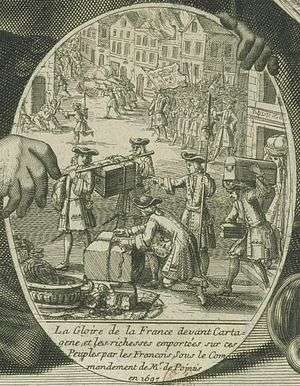Raid on Cartagena (1697)

The Raid on Cartagena was a successful attack by the French on the fortified city of Cartagena de Indias, on May 6, 1697, as part of the War of the Grand Alliance.
By 1695, the French Navy had declined to the point that it could no longer face the English and Dutch in an open sea battle and therefore had switched to privateering -– guerre de course. Bernard Desjean, Baron de Pointis, active in the Caribbean from the beginning of the war, was able to convince King Louis XIV of France to let him try a daring attack on the richest city of the region, Cartagena, in present-day Colombia.
He received command of a fleet of seven capital ships, three frigates, and some smaller vessels. The squadron left from Brest, France, on January 7, 1697, and arrived at Saint-Domingue in the West Indies on March 3rd. Pointis requested assistance from governor Jean du Casse, who gave his support only reluctantly, as he preferred an attack on Portobelo. One month later, a fleet with 1,200 soldiers and 650 buccaneers appeared before Cartagena.
The renewed Spanish defenses were not what the had once been, and some writings say that the French had bribed the commander of the Castle of Castillo Grande, Francisco Santaren. Starting april 1697, the French fleet arrived to Cartagena, and discovered that they could not take land in front of the city, so they decided to enter the bay. The first battle was against the castle of San Luis de Bocachica, defended by 139 men and his Lord of the Castle, Don Sancho Jimeno, a fortress that protects the bay entrance in the only thin zone, called the Small Entrance (Bocachica). The fortress was taken in two days between the 13th and the 15th april 1697.
The French and pirate navy continued by the bay and the land forces walked by the coast of the island of Tierrabomba after taking the castle of San Luis, and they meet in the entrance of the small bay where the Spanish forces had abandoned the fortress of Castillo Grande and El Pastelillo. The land forces cannot attack Cartagena following the land route because of the still well defended bastions of Santa Catalina, so they were transferred to the island of Manzanillo and they sieged the last fortress of San Lazaro (today the Castle of San Felipe de Barajas) that offers a little of resistance from its commander Juan Manuel Vega, who died in the fight. Then, the French and the pirates took the way to the city and sieged it. Pointis forces has losing only sixty men. The city was surrounded the 5th may 1697 by its governor Don Diego de los Rios, and the French allowed him and some important people to escape with some money to Mompox. Between May 6th and 24th, the French plundered the city, accumulating loot valued at ten to twenty million livres.
Pointis then set sail directly for France, cheating his buccaneer allies of their promised share of the loot. Outraged, the buccaneers returned and plundered the city once more, this time untempered by the French regular soldiers, in an orgy of rape, extortion and murder.
Aftermath

On his return voyage to France, Pointis managed to avoid the English admiral John Nevell, whose squadron had been diverted from Cadiz, Spain, to pursue the French privateer. After a three-day chase, Nevell had captured only one ship. Unfortunately for him, this was a hospital ship infested with yellow fever, which now spread through the English and Dutch fleets. The disease killed 1,300 English sailors, six captains, and Admiral Nevell himself; only one captain in the Dutch fleet survived.
The French did not escape unscathed, as yellow fever spread through their fleet, too, killing hundreds of sailors. However, Pointis made it back to France and gave Louis XIV his share of two million livres. The rest of the loot made Pointis an immensely rich man.
He published Relation de l'expédition de Carthagène faite par les François en 1697 in Amsterdam the next year.
References
- Lynn, John A. The Wars of Louis XIV: 1667–1714. Longman, (1999). ISBN 0-582-05629-2
- Roger N.A.M. The Command of the Ocean: A Naval History of Britain 1649–1815, Penguin Group, (2006). ISBN 0-14-102690-1
External links
- La prise de Carthagène - 1697 (French)
Coordinates: 10°24′41″N 75°32′06″W / 10.4114°N 75.5350°W